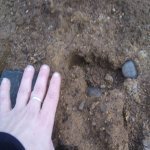As part of my volunteer work for the Montana Military Museum over the last decade, I spend a lot of time looking at and restoring historical photographs, some dating back to the 1880's. In April I began experimenting with a colorization program called DeOldify licensed by MyHeritage. It can bring the subject of an old photo to life, in a manner of speaking. I've used it on a number of the museum's photos of Montana infantry units taken from the 1890's through the 1930's. We know the actual colors of uniforms, pennants and flags, etc., shown in the photos and the program does a remarkable job of rendering them accurately. I was primarily interested in the photo of Khwit as it is the best preserved as well as generationally closest to Zana. My goal was to adjust exposure to try and give more depth to the face, allowing a possibly more accurate assessment of the underlying bone structure (I also found it interesting that the hair was rendered in the auburn shade fitting the "long, reddish-brown hair" described in "The Nature of the Beast" quoted above). Based on the neutral background I suspect the photo was exposed with artificial light, i.e. flash powder in that era, which would explain the high contrast exhibited. Khwit's nose appears wide considering the otherwise long, narrow face, and while the original photo suggests a high forehead, reflection of light to the camera lens is similar from the bridge of the nose and the forehead above the brow which indicates a similar sloping plane to both surfaces. As hiflier pointed out, the ears definitely seem low and it's easy to see that if that thick hair was allowed to grow out it could cover them entirely which fits with the many sasquatch witness descriptions that ears were not seen. If I saw that photo with no knowledge of the provenance it would appear to be or a fairly well proportioned, rangy human male. If his body was proportioned with the skull pictured above however, he must have been extraordinarilly tall and powerfully built.
The heading over the photos doesn't provide the identity of the "leading genetecist" who suggests Zana may have been a yeti, but all of the purported yeti tracks I'm aware of show an ape like foot rather than human like. While I understand the genetic basis for the current primate designations (and ignoring the persistent suspicion that some scientists delight in obfuscation), the lexicon of Ivan Sanderson's day dividing the branches as Hominid or Pongid strikes me as much more descriptive from the standpoint of physical characteristics.



